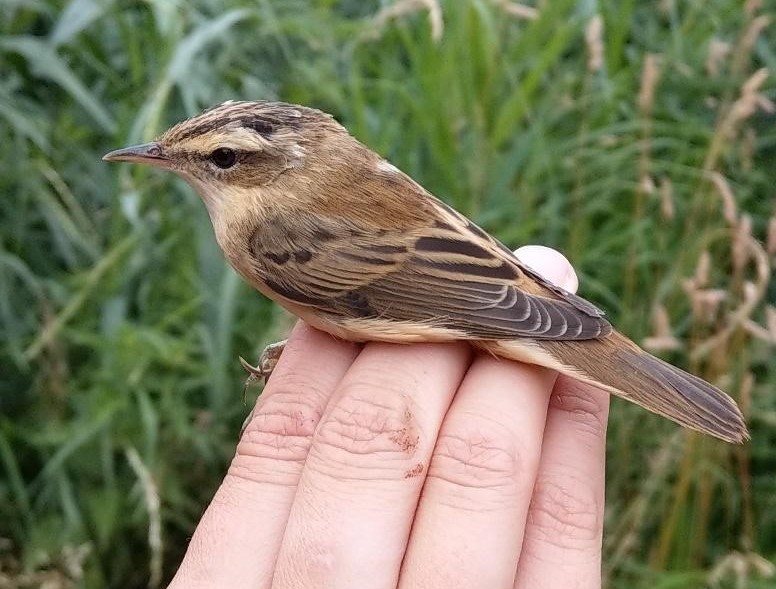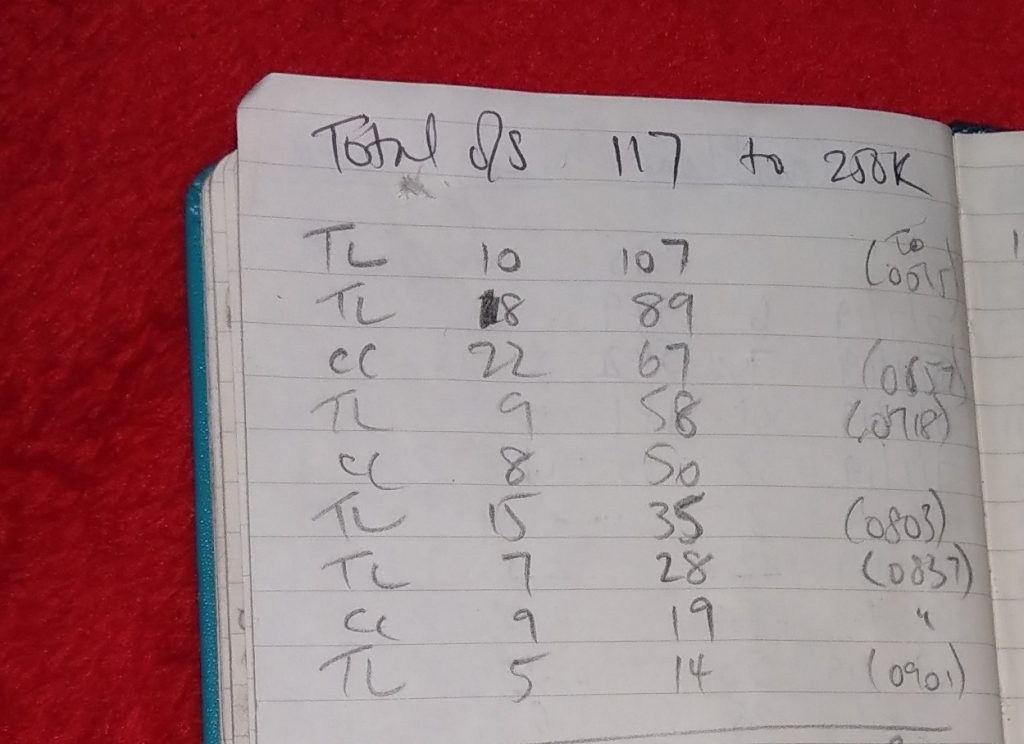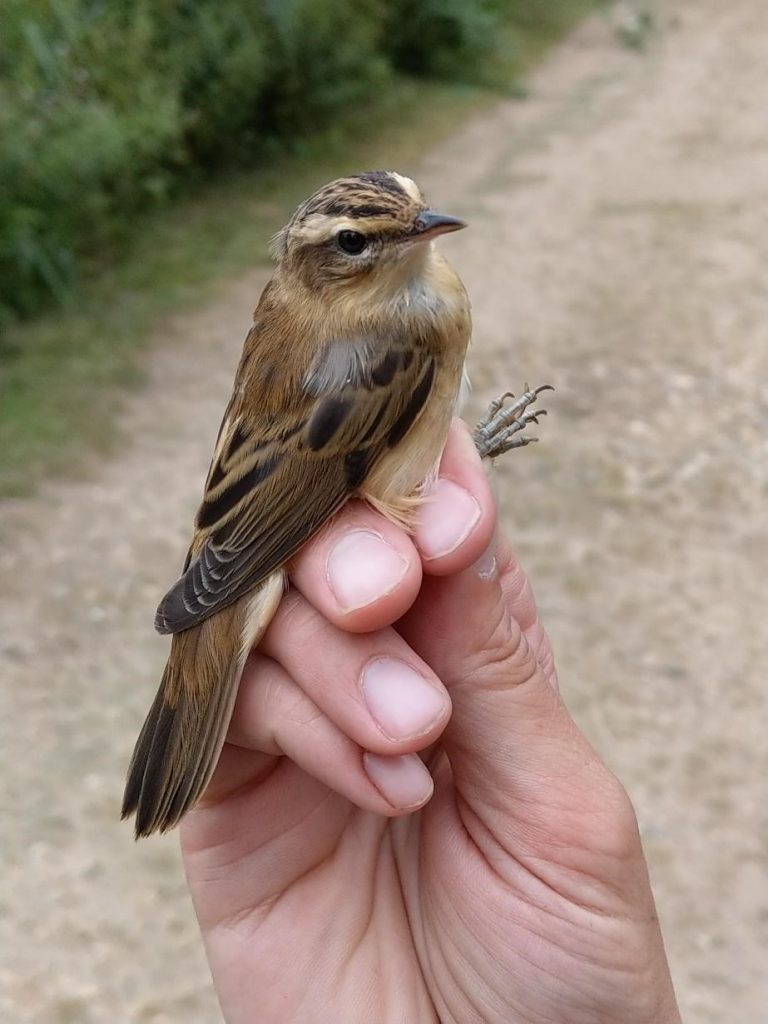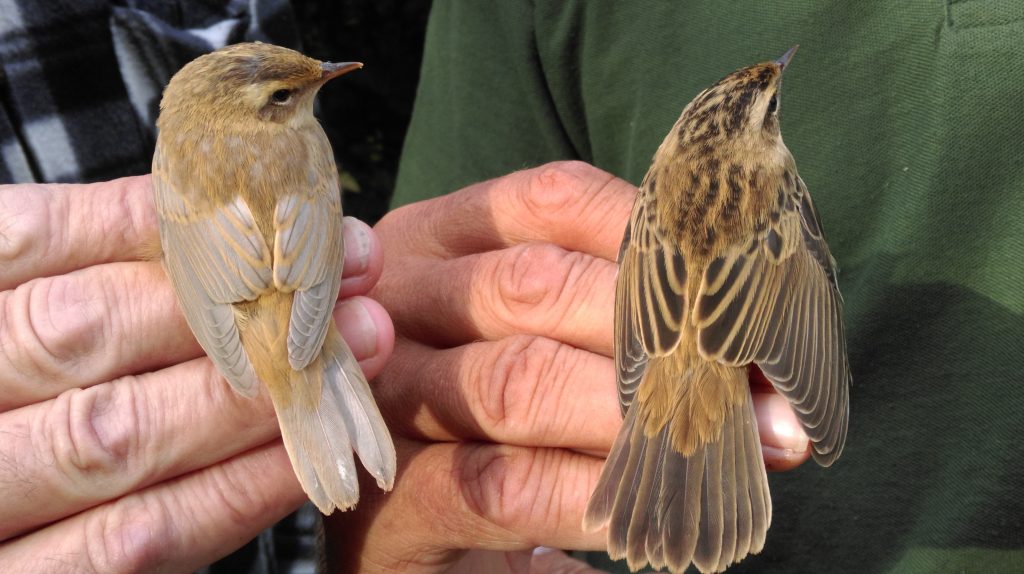Recent activities

One in a (quarter) million…
We’re very proud to announce that on Saturday 13 July 2019 the Rye Meads Ringing Group (RMRG) reached an amazing milestone by ringing the 250,000th bird for the site. Rather fittingly, the bird in question was a Sedge Warbler; to date the most commonly-ringed species at Rye Meads, as Jan Swan explains.
This fantastic achievement is the result of unbroken effort since the very first birds were ringed on site in 1960 by a small group of like-minded people, who had been birding at or near Rye Meads since 1957. Seeing the potential of the site as an inland bird observatory they achieved the formal creation of RMRG in 1962, the structure and aims of which have carried on to this day.
Bird ringing in Britain and Ireland started over 100 years ago, originally to answer questions around how long birds lived as well where they relocated to and the timing of those movements. Given the increased pressure on birds both in terms of habitat loss and environmental changes, more recently the focus has been on monitoring bird populations; from chicks in the nest through to fledged juveniles then into adulthood; year on year survival and subsequent breeding successes.
RMRG contributes to these studies in a variety of ways. Firstly, the group runs two Constant Effort Sites (CES) from May to September each year. These have been in operation since 1993 so we’re acquiring lots of standardised, and therefore highly comparable information about the site and the species we catch during that time, especially in relation to returning adults and fledged young.
Alongside CES, we carry out what is probably the most useful and important survey we do for our conservation partners; a complete breeding survey. This provides them with a full picture of which species are breeding as well as where they are on site. In turn that allows our partners to tailor management to species of concern. Such initiatives can really boost breeding numbers of some species where, for example, better quality wet reedbeds have benefitted Reed Warbler, Pochard and Water Rail. Sometimes, as is the case with Sedge Warbler, our best management efforts are to no avail, reinforcing the notion that its problems lie away from Rye Meads, as can be seen in Figure 1 below;

This monitoring activity also ties in with our involvement in the Nest Record Scheme (NRS) and to date we have submitted an average of 241 nest records per year! As for our star species, in 2016 we submitted 40% of the total UK nest records for Sedge Warbler! What makes nest recording even more useful is that the pulli are ringed, so we know exactly how old they are as well as their provenance, should they ever be re-caught. Additionally, the nests on the gull and tern colony rafts are mapped and we make several, brief visits throughout the breeding season to ring the chicks.


The same Sedge Warbler nest at egg and chick stages (Alan Harris)
We’ve also been involved in colour-ringing Green Sandpiper as part of a wider project to monitor movements of these small waders. Our main success from this project comes from an adult bird we colour-ringed in 2013, which has frequented the site in autumn and winter each year since we ringed it. However, the best news came in April 2018 when it was photographed in NW Norway and identified from its colour rings! Thoughts are that it was either at or near its breeding grounds and this sighting gave the group its first foreign recovery of this species.
Later in the year our attention turns from summer visitors to using duck traps to catch ducklings and wintering wildfowl. We generally catch just over 50% of total of Little Grebes ringed across Britain and Ireland. Plus, in 2017, although we only ringed one Pochard, it was 25% of the total number ringed in Britain and Ireland.
However, it’s not just bird ringing we get involved in; we also carry out Wetland Birds Surveys (WeBS) throughout the winter months, have an official BTO/JNCC/RSPB Breeding Bird Survey (BBS) square overlapping the site, and carry out whole-site territory mapping in the spring and summer. In winter, we have our version of a winter bird census called Dryland Bird Survey (DriBS) and complete observation logs after each visit to the site (often at least twice a week) throughout the year. We don’t stop at birds though, we also log sightings of butterflies, moths and mammals.
As you can see from the above, we collect and contribute a substantial amount of valuable data across all our activities, forming a well-rounded picture of the site’s environmental health. Ringing forms part of this monitoring and our aim isn’t to achieve ringing targets, but it is incredibly rewarding to see a milestone reached and to think about all that data!
Now back to the remarkable bird in question…
We estimated back in February that we would ring the group’s 250,000th bird either in July or August. So once June had finished, I started meticulously keeping a tally of the number of birds ringed each weekend and emailed the outstanding total to group members.
After a particularly concerted ringing effort during the weekend of 6/7 July we were left with just 143 birds to ring, so we knew that M-Day would (should) happen the following weekend; as long as the good old British weather behaved! Emails between group members then flew back and forth throughout the week and plans were eventually hatched (excuse the pun!) to net two different sites on the Saturday. With the help of some mid-week mist-netting and pulli-ringing, the total was brought down further to just 117 by the end of Friday 12 July!
Morning mist netting always starts when the birds are most active so, bleary-eyed, we convened at 0400 on Saturday 13 July and went about netting two sites; Roger and myself (and later Toby) were at the Tealeaves which is an area of scrub, and Sarah and Alan were in the Thames Water south lagoons, which generally yields a mix of tits and warblers.

As each net round finished, I fired off a text to Sarah and then scribbled the totals in my notebook and updated the number we had left, the excitement was mounting…
Then, with just 14 birds to go, at 0907 my mobile lit up with an incoming call from Sarah, ‘I think I’ve got it!!!’ she said excitedly.
Roger and Toby had the netting and ringing at the Tealeaves under control so I hot-footed it to the south lagoons and met Sarah at the ringing hut. The birds were hung up in their bird bags in strict ‘caught-by’ order and we set about processing the birds. With the last handful of birds to process, Sarah had a momentary lapse in confidence ‘I really hope I counted the retraps right!’ We were up to 13 new birds. The next bird out was a retrap!!! Had Sarah really had a mix-up under the pressure of it all and her 3:30am alarm!!
Then came the final bird, the bird we’d been anticipating since February; the 250,000th bird to be ringed at Rye Meads, a quick check of the next and final bird from this net-round, and a smug face from Sarah – it was un-ringed! Phew!
Sarah handed the bird to me saying something along the lines of, ‘Here, you should ring this. You’re Ringing Secretary, you enter and submit all the Groups ringing data, and I’m practically a visiting ringer these days!’. So, I took the bird bag and nervously reached in, got the bird safely held in the ringer’s grip and removed it from the bag. My face, apparently, ‘was brilliant’ when I realised that it was a stunning Sedge Warbler. This is especially fitting as it’s our most common-ringed species!!

It was duly ringed and processed and we also had time to quickly take a couple of photographs for posterity before letting it go.

From a personal perspective, having been at RMRG for nearly 10 years and attained the dizzy heights of Trainer and Ringing Secretary, I feel extremely privileged to have been the person to ring this milestone bird.
As mentioned, Sedge Warbler is currently our most-ringed species; at the end of 2018 we had ringed 24,014 of them and second place went to Reed Warbler with 17,361, a difference of 6,653 birds. This gap, however, is slowly decreasing following the decline in Sedge Warbler survival rates, attributed to the lack of rains in the West African Sahel just south of the Sahara, where they spend their winters.
The series of charts below display the top five species we have regularly ringed each year since 20071. As you can see Reed Warbler has been top or in second place in each year. Sedge Warbler on the other hand has been absent from the top five species list for the past two years and had mixed fortunes in the remaining years shown.












1 General ringing totals will often have bias when it comes to totals, but ours flagged up a couple of real outlier species where we caught high numbers, eg birds going to roost. These have been removed in order to concentrate on species we would catch during ‘normal’ operations, the majority of the time. These relate to years 2016 (Swallow – 386), 2015 (Swallow – 488), 2014 (Swallow – 1211) and 2012 (Swift – 278).
So, the general trend over the past 12 years appears to be that Reed Warbler numbers, or our ability to catch them(!), have improved as can be seen on the trend line on the graph below;

‘Our’ milestone bird joins a group of other Sedge Warbler at Rye Meads, which have also been remarkable in some way…
The furthest-travelled Sedge Warbler ringed at Rye Meads had ring number B544 082 and was ringed on 10 September 1982. It was recovered nearly two years later, on 24 August 1984, between Marrakech and Settat in Morocco; a distance of 2235 km;

On 27 June 2017 we caught this striking-looking juvenile Sedge Warbler in our north CES site. The bird appears to have a lack of the darker melanin pigment in its feathers; an effect known as leucism. The normal-looking bird on the right is there for comparison.

After being ringed at Rye Meads, five Sedge Warblers have travelled over 500km in 14 days or less, all of which were controlled in France. See map below for the corresponding pin colour;

Y662 095 was ringed on 10 August 2013 and was controlled on 20 August 2013 in Le Branzais, Penestin, Loire-Atlantique (525km in 10 days)
S118 881 was ringed on 7 September 2016 and was controlled on 19 September 2016 also in Donges, Loire-Atlantique (517km in 12 days)
V417 324 was ringed on 11 August 2007 and controlled on 25 August 2007 in Donges, Loire-Atlantique (517km in 14 days)
F674 408 was ringed on 11 August 1990 and was controlled on 25 August 1990 in St Philbert de Grand Lieu, Loire-Atlantique (541km in 14 days)
V417 721 was ringed on 25 August 2007 and was controlled on 4 September 2007 in Villeton, Lot-et-Garonne (825km in 10 days)
Our most recent control Sedge Warbler is a bird bearing ring number Paris 7516 851. It was originally ringed as a juvenile at Trunvel, Treogat, Finistère in France on 1 August 2015. We have then controlled it during the breeding season in 2016, 2017, 2018 and now twice this year so we think it must have been raised at or near our site as they generally come back to breed at their natal site.


As for birds which have been ringed elsewhere and re-caught by us (known as controls), the Sedge Warbler which has travelled the furthest to reach us was a French-ringed juvenile bird bearing ring number Paris 3122 572. It had been ringed at St-Seurin-D’Uzet, Charante-Maratime on 13 August 1987 some 701km away. We then controlled it on 26 July 1988, so again it may have bred either on site or locally, or it was merely passing through.
A massive thank you is called for
Firstly, whilst writing this blog over the past few weeks I had intended to include a list of everyone who’s contributed to the huge amount of data we’ve amassed since the first bird was ringed in 1960. These will have been the many Rye Meads regulars over the years as well as folk who’ve attended ringing courses, those who’ve visited for a ringing session or two or people who’ve reported a ringed bird; it’s all important information. Having looked at the database we have 283 ‘observers’! Sadly though, we don’t currently have everyone’s name so I will just say that if you’re reading this and know you are one of those 283 people, please accept this sincere thank you for adding to our growing bank of data; we couldn’t have done it without you!
Secondly, were it not for RSPB Rye Meads, Herts Wildlife Trust, Thames Water and Lee Valley Park supporting our work and permitting access to Rye Meads we would not be able to carry out any of our studies. So, a huge thank you to those organisations too. Finally, a thank you to the British Trust for Ornithology, who run the ringing scheme, collate and use the data we collect through ringing and our other monitoring activities in conservation research.
Thirdly, this is for Sarah Harris and Alan Harris; thank you both for your invaluable input into this blog and ace proof-reading skills!
Learn more about our studies…
For anyone interested in a more detailed account of the group’s first forty years of involvement in the ringing scheme don’t forget you can buy our brilliant book, The Birds of Rye Meads.
If you’d like to support our continuing studies of the wildlife at Rye Meads, please consider becoming a Friend of RMRG or make a donation today – it cost 26p to fit the ‘A’ ring to our ‘special Sedge Warbler’ alone. Please click here for more details. Thank you.

Congratulations to all. In fact, good job!
Thanks Brian – every single ringer over the past 59 years has played their part!
What a mega blog! Thanks for putting this together Jan!